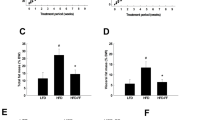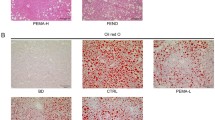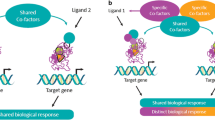Abstract
Fenofibrate, a selective 1PPAR-α activator, is prescribed to treat human dyslipidemia. The aim of this study was to delineate the mechanism of fenofibrate-mediated reductions in adiposity, improvements in insulin sensitivity, and lowering of triglycerides (TG) and free fatty acids (FFA) and to investigate if these favorable changes are related to the inhibition of lipid deposition in the aorta. To test this hypothesis we used male LDLr deficient mice that exhibit the clinical features of metabolic syndrome X when fed a high fat high cholesterol (HF) diet. LDLr deficient mice fed HF diet and simultaneously treated with fenofibrate (100 mg/kg body weight) prevented development of obesity, lowered serum triglycerides and cholesterol, improved insulin sensitivity, and prevented accumulation of lipids in the aorta. Lowering of circulating lipids occurred via down-regulation of lipogenic genes, including fatty acid synthase, acetyl CoA carboxylase and diacyl glycerol acyl transferase-2, concomitant with decreased liver TG and cholesterol, and TG output rate. Fenofibrate also suppressed liver apoCIII mRNA levels and markedly increased lipoprotein lipase mRNA levels, known to enhance serum TG catabolism. In addition, fenofibrate profoundly reduced epididymal fat and mesenteric fat mass to the levels seen in lean mice. The reductions in body weight were associated with elevation of hepatic uncoupling protein 2 (UCP2) mRNA, a concomitant increase in the ketone body formation, and improved insulin sensitivity associated with tumor necrosis factor-α reductions and phosphoenol pyruvate carboxykinase down-regulation. These results demonstrate that fenofibrate improves lipid abnormalities partly via inhibition of TG production and partly via clearance of TG-rich apoB particles by elevating LPL and reduced apoCIII. The prevention of obesity development occurred via energy expenditure. Fenofibrate-mediated hypolipidemic effects together with improved insulin sensitivity and loss of adiposity led to the reductions in the aortic lipid deposition by inhibiting early stages of atherosclerosis possibly via vascular cell adhesion molecule-1 (VCAM-1) modulation. These results suggest that potent PPAR-α activators may be useful in the treatment of syndrome X. (Mol Cell Biochem xxx: 1–16, 2005)
Similar content being viewed by others
Abbreviations
- PPAR:
-
Peroxisome proliferator activated receptor
- LDLr:
-
low density lipoprotein receptor
- SREBP1:
-
Sterol response element binding protein 1
- DGAT2:
-
Diacyl glycerol acyl transferase
- PEPCK:
-
Phosphoenol pyruvate carboxy kinase
- TNF-α:
-
Tumor necrosis factor alpha
- UCP:
-
Uncoupling protein
- LPL:
-
Lipoprotein lipase
- ACO:
-
Acetyl CoA oxidase
- ACC:
-
Acetyl CoA carboxylase
- FAS:
-
Fatty acid synthase
- VCAM1:
-
Vascular cell adhesion molecule 1
- HAEC:
-
Human aortic endothelial cell
References
Moller DE, Kaufman KD: Metabolic syndrome: A clinical and molecular perspective. Annual Review of Medicine 56: 45–62, 2005
Reaven GM: Pathophysiology of insulin resistance in human disease. Physiol Rev 75: 473–486, 1995
Srivastava RAK Srivastava N: Search for obesity drugs: targeting central and peripheral pathways. Curr Med Chem- Immunol, Endo & Met Ag 4: 75–90, 2004
Szapary PO, Rader DJ: The triglyceride-high-density lipoprotein axis: an important target of therapy? Am Heart J 148: 211–221, 2004
Sowers JR, Epstein M, Frohlich ED: Diabetes, hypertension, and cardiovascular disease: an update. Hypertension 37: 1053–1059, 2001
Norhammar A, Malmberg K, Diderholm E, Lagerqvist B, Lindahl B, Ryden L, Wallentin L: Diabetes mellitus: the major risk factor in unstable coronary artery disease even after consideration of the extent of coronary artery disease and benefits of revascularization. J Am Coll Cardiol 43(4): 585–591, 2004
Candido R, Srivastava P, Cooper ME, Burrell LM: Diabetes mellitus: a cardiovascular disease. Curr Opin Investig Drugs 4: 1088–1094, 2003
Rubins HB: Triglycerides and coronary heart disease: implications of recent clinical trials. J Cardiovasc Risk 7: 339–345, 2000 (Review)
George Steiner and Diabetes Atherosclerosis Intervention Study Investigators. Effect of fenofibrate on progression of coronary-artery disease in type 2 diabetes: the Diabetes Atherosclerosis Intervention Study, a randomised study. Lancet 357: 905–910, 2001
Krentz AJ: Lipoprotein abnormalities and their consequences for patients with type 2 diabetes. Diabetes Obes Metab Suppl 1: S19–27, 2003
Reaven G, Abbasi F, McLaughlin T: Obesity, insulin resistance, and cardiovascular disease. Recent Prog Horm Res 59: 207–223, 2004 (Review)
Kotani K, Peroni OD, Minokoshi Y, Boss O, Kahn BB: GLUT4 glucose transporter deficiency increases hepatic lipid production and peripheral lipid utilization. J Clin Invest 114: 1666–1675, 2004
Adeli K, Taghibiglou C, Van Iderstine SC, Lewis GF: Mechanisms of hepatic very low-density lipoprotein overproduction in insulin resistance. Trends Cardiovasc Med 11: 170–176, 2001 (Review)
Taghibiglou C, Carpentier A, Van Iderstine SC, Chen B, Rudy D, Aiton A, Lewis GF, Adeli K: Mechanisms of hepatic very low density lipoprotein overproduction in insulin resistance. Evidence for enhanced lipoprotein assembly, reduced intracellular ApoB degradation, and increased microsomal triglyceride transfer protein in a fructose-fed hamster model. J Biol Chem 275: 8416–8425, 2000
Fazio S, Linton MF: The role of fibrates in managing hyperlipidemia: mechanisms of action and clinical efficacy. Curr Atheroscler Rep 6: 148–157, 2004 (Review)
Duez H, Lefebvre B, Poulain P, Pineda Torra I, Percevault F, Luc G, Peters JM, Gonzalez FJ, Gineste R, Helleboid S, Fruchart JC, Fievet C, Lefebvre P, Staels B: Regulation of human ApoA-I by gemfibrozil and fenofibrate through selective peroxisome proliferator-activated receptor α modulation. Arterioscler Thromb Vasc Biol 225: 585–591, 2004
Huang B, Wu P, Bowker-Kinley MM, Harris RA: Regulation of pyruvate dehydrogenase kinase expression by peroxisome proliferator-activated receptor-alpha ligands, glucocorticoids, and insulin. Diabetes 51: 276–283, 2002
Frederiksen KS, Wulff EM, Sauerberg P, Mogensen JP, Jeppesen L, Fleckner J: Prediction of PPAR-alpha ligand-mediated physiological changes using gene expression profiles. J Lipid Res 45: 592–601, 2004
Son C, Hosoda K, Matsuda J, Fujikura J, Yonemitsu S, Iwakura H, Masuzaki H, Ogawa Y, Hayashi T, Itoh H, Nishimura H, Inoue G, Yoshimasa Y, Yamori Y, Nakao K: Up-regulation of uncoupling protein 3 gene expression by fatty acids and agonists for PPARs in L6 myotubes. Endocrinology 142: 4189–4194, 2001
Frederiksen KS, Wulff EM, Sauerberg P, Mogensen JP, Jeppesen L, Fleckner J: Differential influences of peroxisome proliferator-activated receptors gamma and -alpha on food intake and energy homeostasis. Diabetes 52: 2249–2259, 2003
Guerre-Millo M, Gervois P, Raspe E, Madsen L, Poulain P, Derudas B, Herbert JM, Winegar DA, Willson TM, Fruchart JC, Berge RK, Staels B: Peroxisome proliferator-activated receptor alpha activators improve insulin sensitivity and reduce adiposity. J Biol Chem 275: 16638–16642, 2000
Guerre-Millo M, Rouault C, Poulain P, Andre J, Poitout V, Peters JM, Gonzalez FJ, Fruchart JC, Reach G, Staels B: PPAR-alpha-null mice are protected from high-fat diet-induced insulin resistance. Diabetes 50: 2809–2814, 2001
Li AC, Brown KK, Silvestre MJ, Willson TM, Palinski W, Glass CK: Peroxisome proliferator-activated receptor gamma ligands inhibit development of atherosclerosis in LDL receptor-deficient mice. J Clin Invest 106: 523–531, 2000
Jeong S, Kim M, Han M, Lee H, Ahn J, Kim M, Song YH, Shin C, Nam KH, Kim TW, Oh GT, Yoon M: Fenofibrate prevents obesity and hypertriglyceridemia in low-density lipoprotein receptor-null mice. Metabolism 53: 607–613, 2004
Aalto-Setala K, Fisher EA, Chen X, Chajek-Shaul T, Hayek T, Zechner R, Walsh A, Ramakrishnan R, Ginsberg HN, Breslow JL: Mechanism of hypertriglyceridemia in human apolipoprotein (apo) CIII transgenic mice. Diminished very low density lipoprotein fractional catabolic rate associated with increased apo CIII and reduced apo E on the particles. J Clin Invest 90(5): 1889–1900, 1992
Haubenwallner S, Essenburg AD, Barnett BC, Pape ME, DeMattos RB, Krause BR, Minton LL, Auerbach BJ, Newton RS, Leff T, et al.: Hypolipidemic activity of select fibrates correlates to changes in hepatic apolipoprotein C-III expression: a potential physiologic basis for their mode of action. J Lipid Res 36: 2541–2551, 1995
Frenkel B, Bishara-Shieban J, Bar-Tana J: The effect of beta,beta′-tetramethylhexadecane-dioic acid (MEDICA 16) on plasma very-low-density lipoprotein metabolism in rats: role of apolipoprotein C-III. Biochem J 298: 409–414, 1994
Bisgaier CL, Essenburg AD, Barnett BC, Auerbach BJ, Haubenwallner S, Leff T, White AD, Creger P, Pape ME, Rea TJ, Newton RS: A novel compound that elevates high density lipoprotein and activates the peroxisome proliferator activated receptor. J Lipid Res 39: 17–30, 1998. Erratum in: J Lipid Res 39: 1317, 1998
Srivastava RAK, Jiao S, Tang J, Pfleger B, Kitchens T, Schonfeld G: In vivo regulation of LDL receptor and apoB gene expressions in inbred strains of mice by dietary fatty acids and cholesterol. Biochim Biophys Acta 1086: 29–43, 1991
Srivastava RAK, Tang J, Krul ES, Pfleger B, Kitchens RT, Schonfeld G: Dietary fatty acids and cholesterol differ in their effects on the in vivo regulation of apoAI and apoAII gene expressions in inbred strains of mice. Biochim Biophys Acta 1125: 251–261, 1992
Ojeda MO, van't Veer C, Fernandez Ortega CB, Arana Rosainz Mde J, Buurman WA: Inflamm Res 54: 74–81, 2005
Srivastava RAK, Toth L, Srivastava N, Maeda N, Schonfeld G: Regulation of the apolipoprotein B in heterozygous hypobetalipoproteinemic knock-out mice expressing truncated apoB, B81. Low production and enhanced clearance of apoB cause low levels of apoB. Mol Cell Biochem 202: 37–46, 1999
Srivastava RAK: Analysis of RNA by Northern blotting using riboprobes. Methods in Molecular Biology 86: 103–112, 1998
Srivastava RAK, Srivastava N, Maurizio A, Lin RC, Korach K, Lubahn D, Schonfeld G: Regulation of apolipoprotein E gene expression by estrogen occurs by translational mechanism via estrogen receptor mediated pathway. J Biol Chem 272: 33360–33366, 1997
Zhang WJ, Frei B: Albumin selectively inhibits TNF alpha-induced expression of vascular cell adhesion molecule-1 in human aortic endothelial cells. Cardiovasc Res 55: 820–829, 2002
Kramer D, Shapiro R, Adler A, Bush E, Rondinone CM: Insulin-sensitizing effect of rosiglitazone (BRL-49653) by regulation of glucose transporters in muscle and fat of Zucker rats. Metabolism 200150: 1294–1300, 2001
Werner AL: Travaglini MTA review of rosiglitazone in type 2 diabetes mellitus. Pharmacotherapy 21: 1082–99, 2001 (Review)
Miyake JH, Wang SL, Davis RA: Bile acid induction of cytokine expression by macrophages correlates with repression of hepatic cholesterol 7alpha-hydroxylas e, J Biol Chem 275: 21805–21808, 2000
Choi JS, Choi YJ, Park SH, Kang JS, Kang YH: Flavones mitigate tumor necrosis factor-alpha-induced adhesion molecule upregulation in cultured human endothelial cells: role of nuclear factor-kappa B. J Nutr 134: 1013–1019, 2004
Urizar NL, Liverman AB, Dodds DT, Silva FV, Ordentlich P, Yan Y, Gonzalez FJ, Heyman RA, Mangelsdorf DJ, Moore DD: A natural product that lowers cholesterol as an antagonist ligand for FXR. Science 296: 1703–1706, 2002
Schreyer SA, Vick C, Lystig TC, Mystkowski P, LeBoeuf RC: LDL receptor but not apolipoprotein E deficiency increases diet-induced obesity and diabetes in mice. Am J Physiol 282: E207–E214, 2002
Schreyer SA, Lystig TC, Vick CM, LeBoeuf RC: Mice deficient in apolipoprotein E but not LDL receptors are resistant to accelerated atherosclerosis associated with obesity. Atherosclerosis 171: 49–55, 2003
Duez H, Chao YS, Hernandez M, Torpier G, Poulain P, Mundt S, Mallat Z, Teissier E, Burton CA, Tedgui A, Fruchart JC, Fievet C, Wright SD, Staels B: Reduction of atherosclerosis by the peroxisome proliferator-activated receptor alpha agonist fenofibrate in mice. J Biol Chem 277: 48051–48057, 2002
Mancini FP, Lanni A, Sabatino L, Moreno M, Giannino A, Contaldo F, Colantuoni V, Goglia F: Fenofibrate prevents and reduces body weight gain and adiposity in diet-induced obese rats. FEBS Lett 491: 154–158, 2001
Schwartz S, Raskin P, Fonseca V, Graveline JF: Effect of troglitazone in insulin-treated patients with type II diabetes mellitus. Troglitazone and Exogenous Insulin Study Group. (1998) N Eng J Med 338: 861–866, 1998
Linden D, Lindberg K, Oscarsson J, Claesson C, Asp L, Li L, Gustafsson M, Boren J, Olofsson SO: Influence of peroxisome proliferator-activated receptor alpha agonists on the intracellular turnover and secretion of apolipoprotein (Apo) B-100 and ApoB-48. J Biol Chem 277: 23044–23053, 202, 2002
Frederiksen KS, Wulf EM, Wassermann K, Sauerberg P, Fleckner J: Identification of hepatic transcriptional changes in insulin-resistant rats treated with peroxisome proliferator activated receptor-alpha agonists. J Mol Endocrinol 30: 317–329, 2003
Goudriaan JR, Espirito Santo SM, Voshol PJ, Teusink B, van Dijk KW, van Vlijmen BJ, Romijn JA, Havekes LM, Rensen PC: The VLDL receptor plays a major role in chylomicron metabolism by enhancing LPL-mediated triglyceride hydrolysis. J Lipid Res 45: 1475–1481, 2004
Cases S, Stone SJ, Zhou P, Yen E, Tow B, Lardizabal KD, Voelker T, Farese RV, Jr: Cloning of DGAT2, a second mammalian diacylglycerol acyltransferase, and related family members. J Biol Chem 276: 38870–38876, 2001
Goodpaster BH, Kelley DE: Role of muscle in triglyceride metabolism. Curr Opin Lipidol 9: 231–236, 1998
Ye JM, Doyle PJ, Iglesias MA, Watson DG, Cooney GJ, Kraegen EW: Peroxisome proliferator-activated receptor (PPAR)-alpha activation lowers muscle lipids and improves insulin sensitivity in high fat-fed rats: comparison with PPAR-gamma activation. Diabetes 50: 411–417, 2001
Hotamisligil GS, Arner P, Caro JF, Atkinson RL, Spiegelman BM: Increased adipose tissue expression of tumor necrosis factor-alpha in human obesity and insulin resistance. J Clin Invest 95: 2409–2415, 1995
Hotamisligil GS, Shargill NS, Spiegelman BM: Adipose expression of tumor necrosis factor-alpha: direct role in obesity-linked insulin resistance. Science 59: 87–91, 1993
Staels B, Koenig W, Habib A, Merval R, Lebret M, Pineda Torra I, Delerive P, Fadel A, Chinetti G, Fruchart J -C, Najib J, Maclouf J, Tedgui A: Activation of human aortic smooth-muscle cells is inhibited by PPARalpha but not by PPARgamma activators. Nature 393: 790–793, 1998
Fu T, Kashireddy P, Borensztajn J: The peroxisome-proliferator-activated receptor alpha agonist ciprofibrate severely aggravates hypercholesterolaemia and accelerates the development of atherosclerosis in mice lacking apolipoprotein E. Biochem J 373: 941–947, 2003
Li AC, Binder CJ, Gutierrez A, Brown KK, Plotkin CR, Pattison JW, Valledor AF, Davis RA, Willson TM, Witztum JL, Palinski W, Glass CK: Differential inhibition of macrophage foam-cell formation and atherosclerosis in mice by PPARalpha, beta/delta, and gamma. J Clin Invest 114: 1564–1576, 2004
Branen L, Havgaard L, Nitulescu M, Bengtsson E, Nilsson J, Jovinge S: Inhibition of tumor necrosis factor-alpha reduces atherosclerosis in apolipoprotein E knockout mice. Arterioscl Thromb Vasc Biol 24: 2137–2142, 2004
Cybulsky MI, Iiyama K, Li H, Zhu S, Chen M, IIyama M, Davis V, Gutrerrez-Ramos J, Connelly PW, Milstone DS: A major role for VCAM-1, but not ICAM-1, in early atherosclerosis. J Clin Invest 107: 1255–1262, 2001
Author information
Authors and Affiliations
Corresponding author
Rights and permissions
About this article
Cite this article
Srivastava, R.A.K., Jahagirdar, R., Azhar, S. et al. Peroxisome proliferator-activated receptor-α selective ligand reduces adiposity, improves insulin sensitivity and inhibits atherosclerosis in LDL receptor-deficient mice. Mol Cell Biochem 285, 35–50 (2006). https://doi.org/10.1007/s11010-005-9053-y
Received:
Accepted:
Published:
Issue Date:
DOI: https://doi.org/10.1007/s11010-005-9053-y




